How Do I Change Local Files To Work With Upload Manager In Tabletop Simulator
Ever thought about creating a game to play with your friends on Tabletop Simulator (TTS)? Or maybe you're a tabletop game developer looking to prototype games and playtest them online.
There's never been a better fourth dimension to accept reward of TTS'due south versatile gaming environment. Today, we'll teach you how to do just that.
What Is Tabletop Simulator?
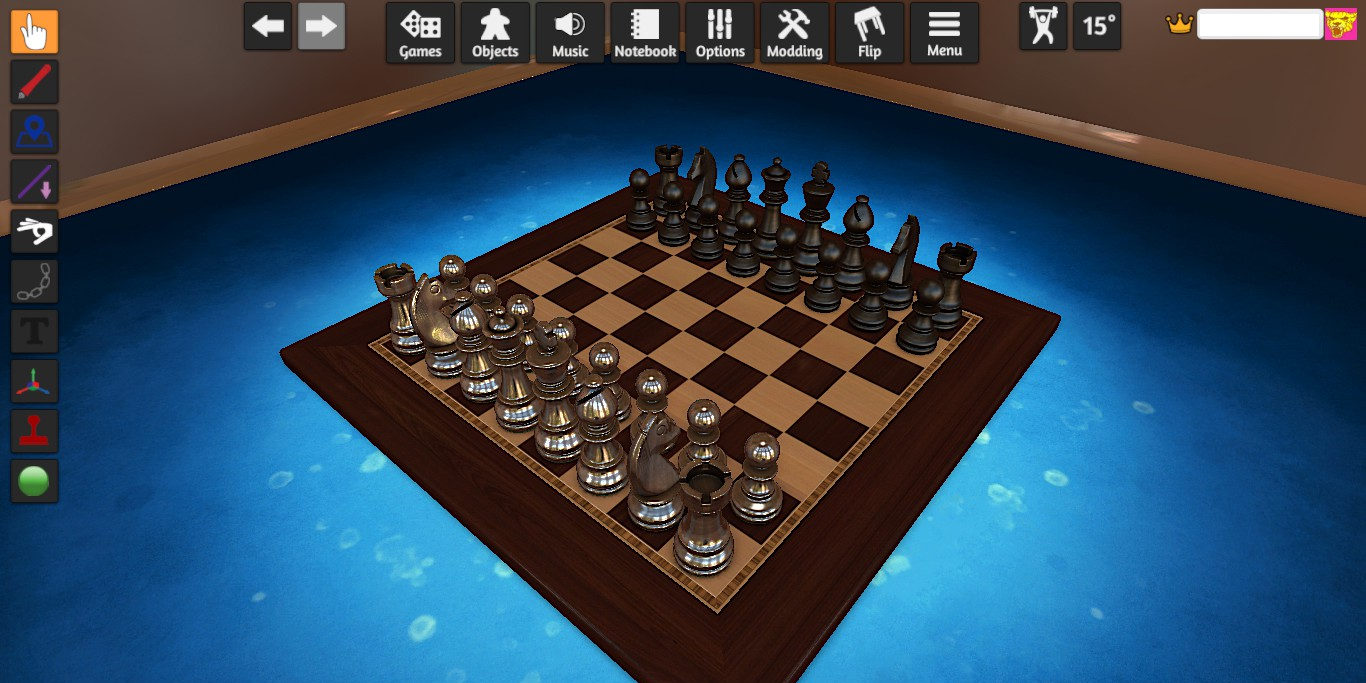
For those who don't know, Tabletop Simulator (TTS) provides a 3D environment for playing tabletop games, either locally or online. It'southward go a peachy way to play board games online with friends.
Playable games on TTS include everything from poker, checkers, Dungeons & Dragons, mini-golf, and even the latest lath games. Any game you desire to play is typically available either as DLC or in the community workshop.
Why Apply Tabletop Simulator?
If yous've ever tried to create a physical tabletop game, you lot know how time-consuming it tin can be, non but to build game elements, merely also to change or supercede them when you lot decide to tweak or revise the game.
In TTS, everything from the color to the weight of an object is changeable with the click of a mouse, making the revision process shine and painless.
In add-on, it'due south easy to alive stream your gameplay and show it off on social media and streaming platforms.
What You lot'll Demand to Become Started
Earlier you brainstorm, y'all'll need the post-obit:
- A Steam user account
- Tabletop Simulator installed on your PC
- JPG images of your lath and card designs
Download: Tabletop Simulator on Steam ($xix.99)
Designing game elements is best done in illustrating software, or by scanning images of concrete cards you've already made. But brand sure they take JPG extensions and are saved individually.
Creating Boards and Player Mats
When y'all're designing your boards and other 2D objects, make sure the resolution is high plenty that you can size information technology right without losing quality. TTS will size it automatically when you import information technology, and you'll be able to resize it exactly how you like.
Creating Cards
Cards in TTS take 3 aspects: the carte du jour face up, the menu back, and the hidden card (what the card will wait similar to others in a player'southward hand). Y'all'll demand to have designs for each of these, although you practice take the option to simply make the hidden carte the back of the card instead.
Create and Arrange Card Faces
Instead of importing each carte 1-by-1, information technology'due south best to import all or well-nigh of your cards as a single deck.
To create a deck, copy and paste each design onto a 7x10 menu sheet. Using a template like the one below will help you go started.
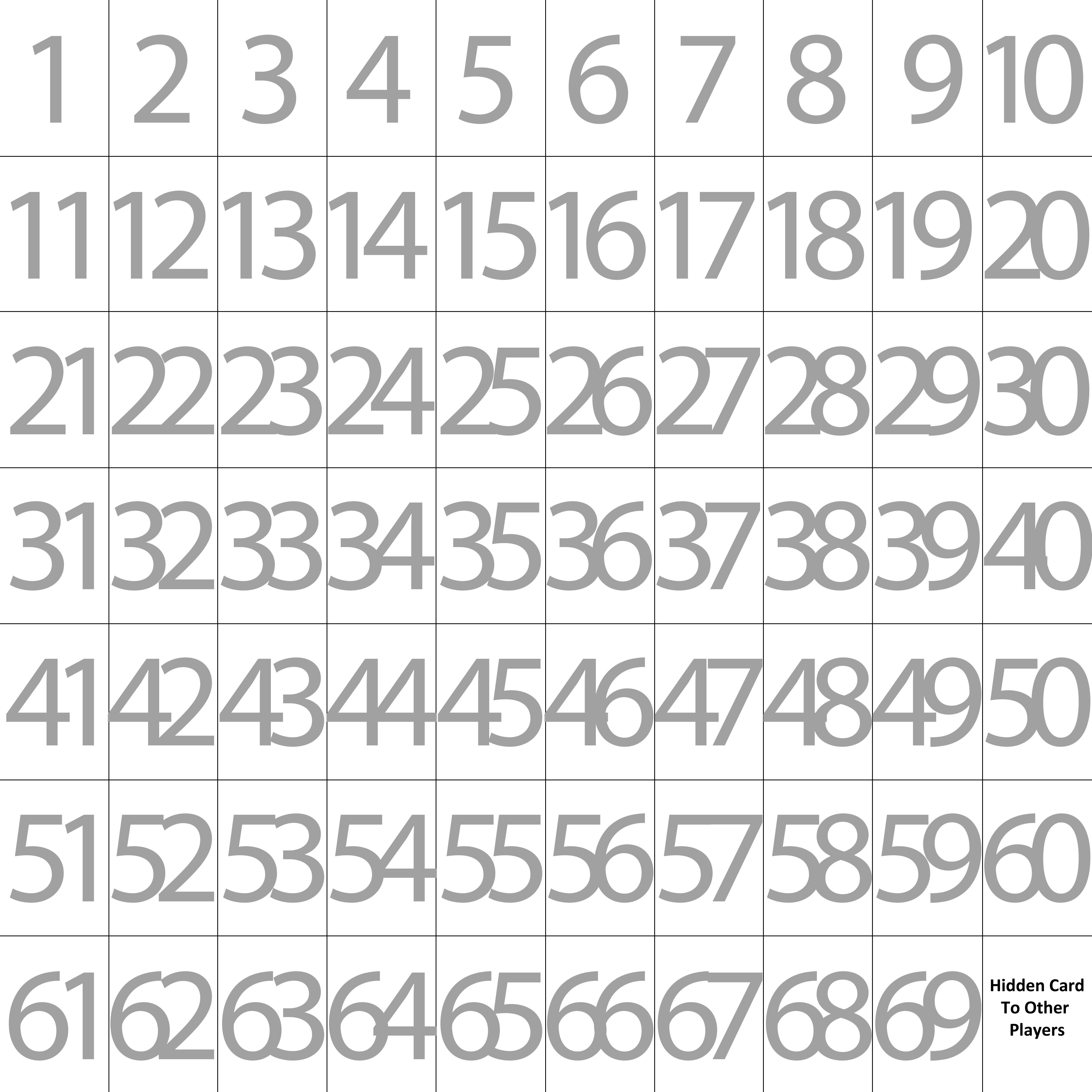
The template delineates slots for each card in your deck, assuasive you to import up to 69 cards at a fourth dimension. If you don't need that many, you can leave slots unused, and if you have more, you lot can combine decks or indistinguishable cards after importing.
However, you don't have to use this template. A card canvass can, in fact, exist any size, and TTS will automatically slice it into a 7x10 filigree.
For your convenience, the in a higher place template and a square carte du jour template are available in your TTS local file directory.
If you're not sure where your local files are, yous tin find them through your Steam library by opening the Properties carte for TTS. Select the Local Files tab and click Browse.

Bill of fare Backs
If you lot simply want one design for the whole deck'southward back, then all you need is a unmarried JPG image of the design; no card canvas will exist necessary.
If your deck is going to take multiple unique backs, you'll need to create an additional card sheet with back designs corresponding to the face designs in your first card sheet. For the face blueprint in slot one, place its designated dorsum in slot ane of your back canvas. For face two, place its dorsum in slot ii, and and then on.
Hidden Cards
In slot 70 of the menu sheet, labeled "Hidden Bill of fare to Other Players" on the template, identify whatsoever pattern yous want to be visible to opponents when the cards in this deck are in a player's hand. This is traditionally solid blackness or white, or features the deck's back design.
Importing Elements
Now that you've created your boards and decks, you lot're fix to kickoff importing.
Before actually hosting a server with your game, it'due south helpful to commencement a single-player game and import the elements ahead of time. You can then salve the setup and exist ready to immediately start when players make it.
Launch TTS and click Create, and and so selectSingleplayer to create the environment. Delete any elements generated by TTS, and select the tabular array y'all'll want your game to exist played on.
With the surround ready, click the Objects push button in the top menu, and and so select the Custom category.
Boards and Histrion Mats
Select Board from the Custom bill of fare, and click wherever on the table you'd like the board to appear. Right-click anywhere to open the board import dialog.
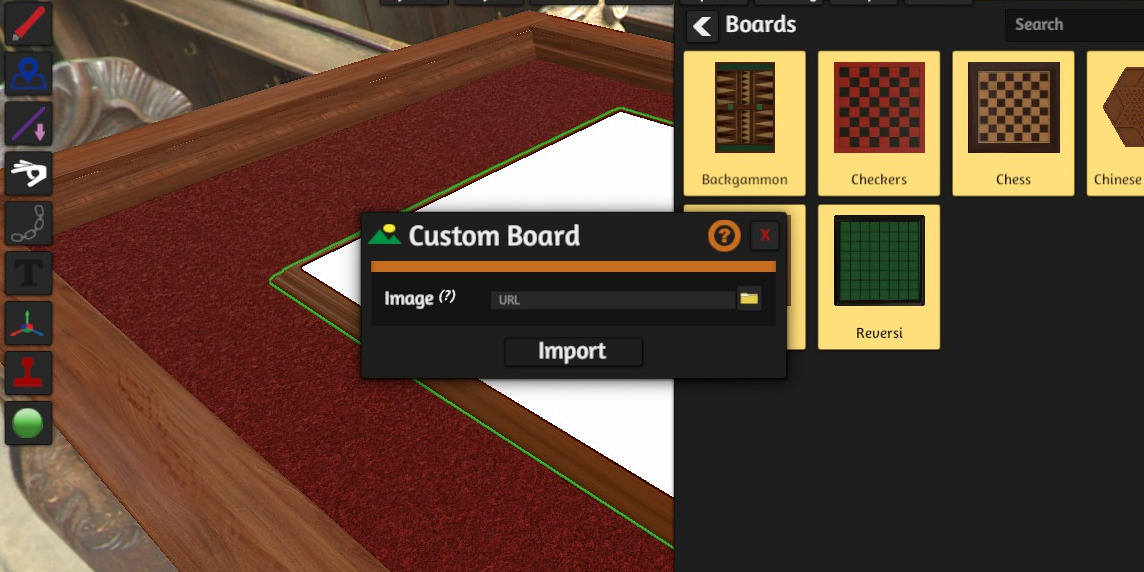
Browse to your image of the board, and TTS will enquire if you want to upload it to your Steam Deject account or keep a local file. Upload the files to the deject if you plan to e'er play your game online or on a different device.
Yous may optionally upload your images on some other host, similar Dropbox, Photobucket, or Imgur, and paste the URL here. External hosts are less reliable, withal, and not recommended.
When you upload it to your Steam Cloud, TTS will ask you to give information technology a file proper noun. One time uploading is finished, click Import.
With the board imported, you can now shrink or enlarge information technology with the- and + keys on your keyboard. To lock it in place so that it isn't accidentally moved during gameplay, right-click on the board, and nether Toggles, click Lock.
Menu Decks
In the Custom Object carte, click Deck. Click wherever on the table you want the deck to appear, and so right-click to offset the import.
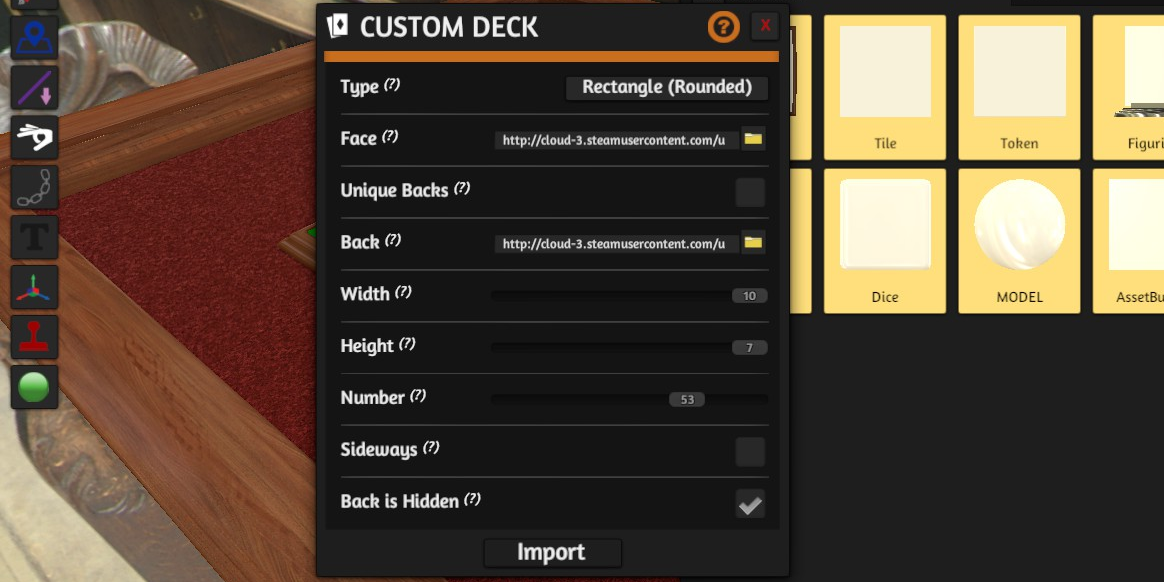
Accommodate the settings as follows:
- Type: Change this if yous take a specific shape in mind other than a regular circular-corner rectangular card.
- Face: Click the Browse Local Files button and find your face bill of fare sail. Once more, we recommend the Steam Cloud selection over local files or outside hosts.
- Unique Backs: Cheque this option if your deck volition accept multiple back designs, and and then upload your back card sheet in the Dorsum box. If you lot're using a unmarried design for the whole deck, merely upload your back design instead.
- Width and Tiptop: Accommodate this if yous used a unlike ratio than the standard rectangular card, 10x7.
- Number: Make certain this matches the number of cards you're importing.
- Sideways: This changes the orientation for the Alt Zoom part in TTS. Leave it unchecked unless you want the card to appear sideways.
- Back is Hidden: Check this if you desire the hidden view of your cards to only exist the backs of the cards.
When your settings are correct, click Import. Your deck will appear on the table, and you can kickoff shuffling and dealing.
If you want your cards to have names to aid with sorting, right-click on a single menu and click Name.
Importing Other Game Elements
Importing other 2D objects is like to the procedure of importing boards. Don't forget that TTS has many common gaming elements, similar dice and figurines, gear up to use in the Objects carte du jour.
If you have custom 3D elements you want to use, follow TTS's guide to importing 3D models.
Saving a Complete Game
After arranging the components in an initial setup country, click the Games push in the top carte du jour.
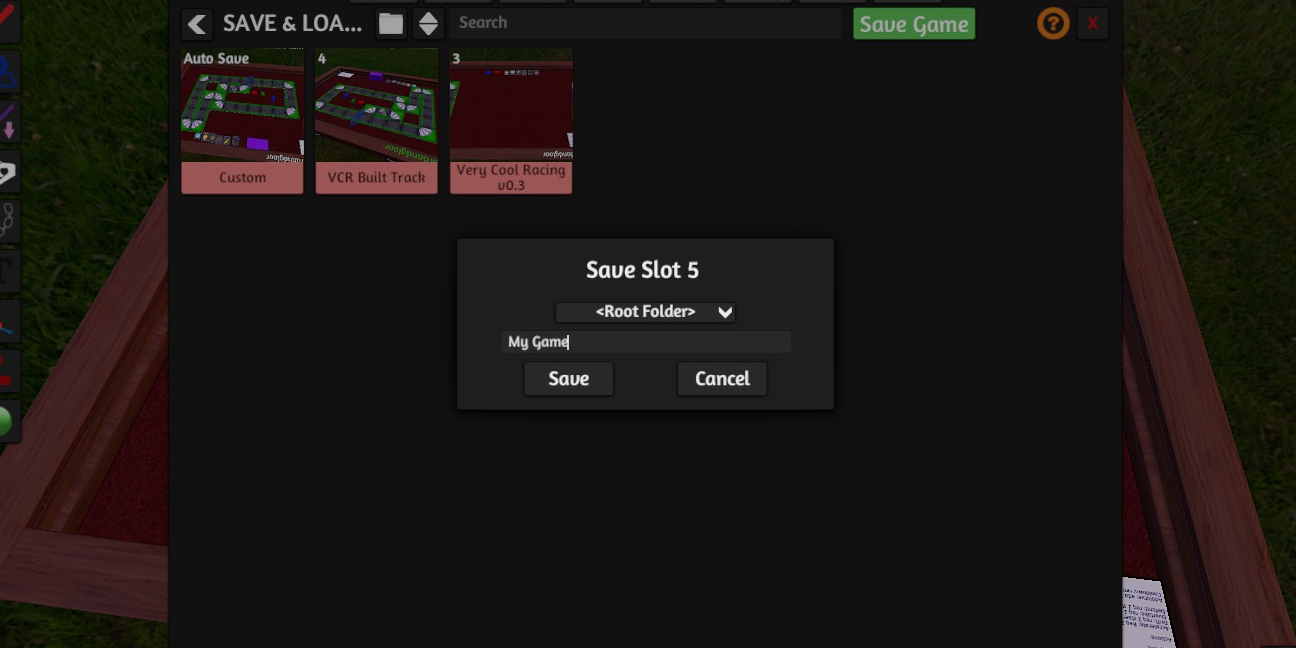
Select Save & Load and click the Save Game button. Give it a name and click Save. At present, whenever you host games, you can reload information technology in the perfect setup by accessing the Salve & Load menu.
Making the Most of Custom Tabletop Gaming
Designing and playing custom games is elementary in Tabletop Simulator once you know how to practise it. Invite your friends, or look for ready and willing playtesters in the TTS customs. At present, you lot tin can show off your custom game to others!
About The Writer
Source: https://www.makeuseof.com/how-to-make-custom-board-game-tabletop-simulator/
Posted by: linnlefuld1996.blogspot.com


0 Response to "How Do I Change Local Files To Work With Upload Manager In Tabletop Simulator"
Post a Comment